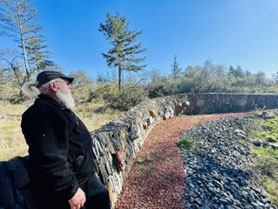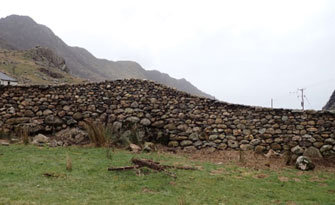
The Wales branch of the Dry Stone Walling Association are delighted to learn that Sean Adcock BEM was listed in the New Year Honours List for 2024. The honours “recognise the achievements and service of extraordinary people across the UK” (The Gazette, www.thegazette.co.uk. 2023) . The British Empire Medal was awarded to the Master Craftsman for service to dry stone walling.
Update: 03.01.2024
DSWA Wales contacted Sean and asked if he would like to issue a response and publish a short biography.
Sometime in the middle of November I’d just arrived home to be greeted by “open your letter, open your letter”. I was heading upstairs to attend to something urgent and was accompanied by Brenda’s chorus… “open…” As I stood there I thought, well she normally only gets excited if it’s from the Premium bonds, and then it only ever turns out to be £25. What’s more there were a couple of interesting Screwfix parcels demanding my attention too. I prevaricated. Brenda was getting more insistent, so I picked up the envelope without really looking at it. Hmm bigger and thicker than I expected, good quality…. Ooo maybe we’ve won something more than £25. I hadn’t noticed ‘Urgent and Personal’, ‘Cabinet Office’ on the envelope, I doubt I would have twigged if I had. Government headed paper emerged, my instant thought maybe Rishi wanted me to join some committee about rural crafts, who knows. Then I read the first line…”I am writing to you in the strictest confidence to inform you that you are to be recommended to His Majesty the King for the honour…”
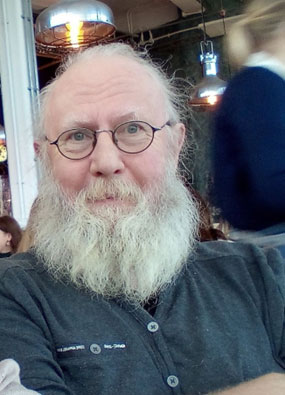
Possibly better than the premium bonds
I was dumbfounded… “well” came the question, I managed to splutter something out .. her reply along the lines of “I thought it might be something like that”
The next six weeks were an agony of tight lipped-ness for both of us. For me there was research… what’s involved, what happens… eager anticipation, not quite believing it, never entirely convinced it wasn’t an elaborate practical joke, even when the well-spoken young man from the cabinet office phoned to check details and explain a few things, don’t think I really believed it until the papers contacted me a day before the announcement. The fact that enough people could be bothered to nominate me and then the vetting committees agree with them still leaves me a little perplexed. There are undoubtedly more deserving cases out there in so many walks of life who haven’t had the fortune to be nominated. It means a lot to be thought worthy of such recognition and thank you to those who considered me worthy of the effort to fill in the forms. I guess you’re in the readership out there as who else could be bothered, the one thing that seems to be as sacrosanct as not letting on you’ve been honoured before the announcement is official is the secrecy around who nominated you.
So how did I end up here? If I’m not building walls I’m photographing them, or writing about them, or talking about them. If we go away on holiday stone is almost invariably involved somewhere. Brenda loves walking I hate it. I stand up all day, if I’m not working I want to sit, she says she’s never met someone able to be as still as me. Emerson said “Its the not the destination, it’s the journey.” I couldn’t disagree more, but fortunately for me Brenda agrees with Mr Emerson and so somehow our relationship endures as I will walk for miles to photograph a stone.
I suppose it began at Southampton University in the early 80s when I became involved with the British Trust for Conservation Volunteers (BTCV… now The Conservation Volunteers) during my last summer vacation which I filled with walking and conservation work – my last freedom before my final year, hard graft and office life, probably in banking or finance.
My final year was spent studying hard and going out with Hampshire Conservation Volunteers by way of relaxation. As a break from revision in the Easter Vacation before finals I visited a friend I had made at the BTCV conservation centre in Llanberis. By the end of my stay I had decided that on graduating I’d have a gap year working as a volunteer there. 40+ years later its possibly one of the longest gap years on record, too late for a proper job now.
My first introduction to stonework came via stone pitching and mini retaining walls on Snowdon’s PyG track, the rest of the time there was lots of tree-planting, messing around with sand-dunes and fencing A couple of short-lived jobs in footpath work in Scotland and London’s urban fringe followed. My main learning experience there was that bosses and underlings are idiots, telling them that wasn’t always appreciated (a lesson I’ve still not learned) and self employment had to be the way to go. So I returned to North Wales, volunteering again, successfully enduring a job carrying out a detailed survey and writing a report on potential conservation/landscape amelioration sites in Buckley, before eventually setting up as a woodland contractor, with a lot of fencing and a fair amount of footpath work, and very occasionally dry stone walling.
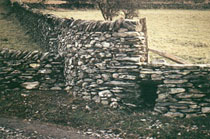
Somehow stonework had always come naturally. I seemed to be able to assess size and shape accurately from day one and stones just wanted to fit together. My stonework went up twice as fast as anyone else’s (I’d probably have a fit if I looked back and saw the quality). I only had a few bits and pieces of wall amongst all my other work, then I was offered several bits of work by another generalist contactor who was employing someone I knew through the volunteers. He was then offered quite a lot of work on the National Trust’s Ysbyty Ifan estate, he didn’t want it and offered the work to me, the Trust were happy if I could put a team together and walling work became my business mainstay. Before long it was more or less full time, and within 2 or 3 years of walling full time I had achieved my Master Craftsman certificate. (Image left: One of my first walls for the National Trust)
I had become involved with North Wales Branch of DSWA before I was self-employed, around a year after its inception, mostly through amateur competitions (with a marked lack of success). Sometime after becoming a master craftsman, I became involved with the committee during the Branch’s most vibrant time including the award of the Branch of the Year when there was no divide between large and small. It was at this time that I started the first incarnation of “Stonechat” and my eponymous “MasterClass” articles. In my first year of self-employment, I had been employed by BTCV to produce a report on Volunteers and Footpath work including some technical sections. The report never made the light of day because it concluded volunteers weren’t always up to the task. In this instance biting the hand that fed me wasn’t a total disaster as at least it showed I could write. Not long after I met Liz Agate, who was writing the BTCV fencing handbook, on a course I was instructing on. We met again when she was revising the sand dune manual. A little later she was about to rewrite the drystone walling handbook and asked if I had any observations. I’m not sure she was ready for the avalanche. I sent a full critique of the then current version with corrections, suggested new content, plus the newly instigated masterclass articles… then just 3 of them. I ended up with a contract (I say contract it barely covered expenses – ever the volunteer) to travel around UK from the Lizard Peninsula to Thurso interviewing Master Craftsmen, and to re-write the technical sections of the manual, and my walling writing ‘career’ was launched. I am more than gratified that my version of the book is often referred to as ‘the waller’s bible’ and little could I have guessed where the writing would eventually lead some 15 years later.
In the meantime, I had started to enter professional competitions, inauspiciously at first. My professional competitive career mirrored my amateur one, no prizes (well I had won a couple in open pairs when a amateur) until a breakthrough came at Sugar Loaf near Brecon during the DSWA’s 1992 grand prix. Still just an initial certificate holder I was runner up in the professional singles. Later that summer as a brand new Intermediate certificate holder (there was no advanced back then and it was at a level somewhere between where intermediate and advanced are now) I placed in the Professional Pairs in the English National Championships alongside partner Garth Heinrich, outscoring all other qualified Grand Prix competitors and even the best placed Master Craftsman, ending up fourth in the Grand Prix. A few weeks later I won my first Professional singles class in Flintshire.
Before retiring from competitions in 2012 (having competed in just shy of 100) I had gone on to win about 30 from the Cotswolds to Edinburgh, placing in around 40 others. I was a proud winner of the North Wales Professional Championship in 6 of the 8 years it was held (I was a judge one year), the Yorkshire Open 6 times including 5 in a row, and 3 competitions in 2 weekends in 2010 yo-yoing from Yorkshire to Lancashire via Vaynor and total exhaustion. At the time, somewhat frustratingly and more than a little sulkily I was twice a runner up in the DSWA Grand Prix. I now look back on those two achievements with a degree of pride. (Image right: Winning 1997 Pentland Open/Grand Prix Final)
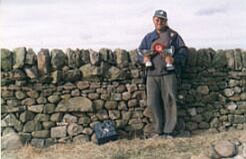
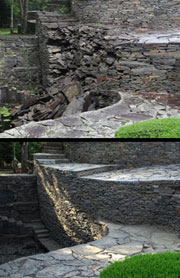
Prior to embarking on my gap year, I had my eyes on a career in international banking and plans to travel the world, a door that I had thought firmly closed once volunteer work and the walling bug had taken a grip. Unbeknownst to me my writing and reputation as a craftsman had spread beyond these shores and in 2010 I was invited to speak at the Stone Foundation’s Symposium in Ventura California, I couldn’t have imagined where that would lead. The talk went well, I was invited back the following year to speak again and also to teach, apparently I was a hit and I made many friends. This in turn led to invitations to attend further festivals in Canada, Judge a competition in Kentucky, teach on private courses, give talks and more stone foundation workshops. (Image left: Opus 40 New York State)
I also got to work on several projects with my by now firm Canadian friend John Shaw Rimmington in the Mendocino Stone zone, which alongside heading a Stone Foundation project to repair a huge retaining wall at Opus 40 (a US National Monument in New York State), are amongst the most incredible creations of my career. In all I have now spent around a year in total in North America talking, teaching, building and just looking. In turn making new contacts and getting new ideas which have led to several revitalisations of “Stonechat”. (Image right: Temple of Imperfections, Mendocino Stonezone. CA)
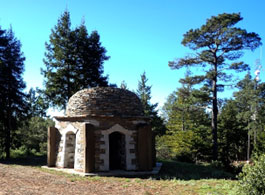
Closer to home I had also been invited to speak at a number of festivals in Eire, as well as having the honour of supervising much of the building of the centrepiece of their memorial to “The Gathering” in the Lough na Boora sculpture park, which in turn led to an invitation to teach Clawdd construction. Cloddiau are one of my pet projects, having taken their instruction to Oregon and Montreal as well as Austria and of course North Wales. (Image right: Clawdd wall. Brynsiencyn, Anglesey.)
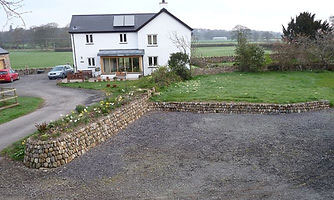
I consider the writing of the bilingual booklet “Clawdd Construction/Codi Cloddiau” as one of my biggest contributions to the craft as so little has been documented about this archetypal Welsh structure. That it is bilingual makes it doubly important I’d like to think that despite my own more than limited knowledge of the language I have been one of its leading proponents as far as the craft of dry-stone walling is concerned.
“Clawdd Construction/Codi Cloddiau” was written in tandem with “Stonework” – often described as ‘how not to build a wall’ – both of which arose from funding made possible by the North Wales Trunk Road Agency following a report I was commissioned to write following the dualling of the A55 across Anglesey and the associated building of several miles of wall. This was at a time when I was secretary and then secretary/ chairman of the North Wales Branch, which also saw me writing many general articles for local magazines/press as well as “Stonechat”.
Masterclass has also been reproduced en masse by the Vermont Stone Trust their funding helping with the production of “Stonechat”. Researching and writing about the structures in the North Welsh slate quarries is a favourite past-time, something of a spin off from my walling treasures website and articles. Most having featured in DSWA’s “Waller and Dyker” alongside more technical articles where I masqueraded as Craig Arbennigol. (Image right: Slatelandia Article in Stonexus Magazine)
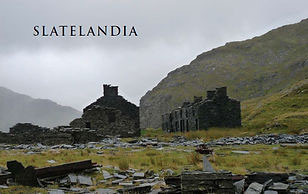
Through my travels around the UK looking at walls I have always been amazed at how little people know about the stonework in their vicinity, either that or they know what’s around but assume that its run of the mill and the same everywhere, not realising that what they have is often close to, if not, unique. I hope my talking and writing has at least done a little to educate in this area. Whilst writing has been a key aspect of my walling life, my bread and butter is building them. I have of course worked on many gardens and some large projects, nothing quite as grandiose or artistic as my American jaunts, but mostly it has been farms. Having eschewed having a workforce I have spent the bulk of the last 20 years working by myself primarily in Nant Ffrancon and the Llanberis Pass where I have completed quite literally, many miles of farm wall, simple boundaries that I like to think I help to flow with the landscape.
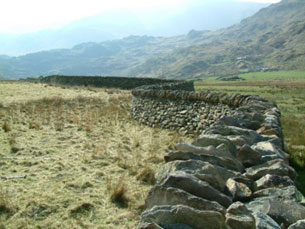
I also hope I’ve shown what can be achieved and that ‘just’ because it’s a ‘boring’ old field boundary it doesn’t just have to be ‘thrown up’. Whilst they are likely not to prove quite as indelible (or perhaps even as illegible) as my writings, I live in the hope that they might inspire others for years to come assuming anyone ever notices them, or realises they are different. That is sadly unfinished work.
(Image left: Farm Boundary, Nant Ffrancon)
In amongst all this I was at one point a trustee of the DSWA of GB. I have also been a DSWA examiner and sometime competition judge again travelling all over uk – this time from Dorset to Perth, and even further afield (Kentucky) with both. I am still responsible for the administration of the Association’s Pinnacle Award scheme. I was also a trainer with ATBLandbase at some point achieving qualifications in coaching and assessment, although cloddiau apart most of my teaching in recent years has been in USA.
Training and grandiose American projects notwithstanding, I am never happier than when alone with the stone on the edge of a field, I just wish it didn’t rain so much around here. Standing near Idwal at the head of Nant Ffrancon and looking down at the valley floor where nearly every wall you can see is ‘mine’ gives a great sense of achievement.
When building the wall at Opus40 I was asked how much stone I had used in my career (Americans cannot believe how fast we have to work here in the UK). We sat down and did a quick calculation taking ‘moved’ rather than ‘used’ as most of what I do involves dismantling them first. We came up with 45000 tonnes, closer to 50k by now. I am fond of saying if a farmer in a field standing in front of a 50k pile of stone had said I’ll pay you for the next 35 or so years to move it all 2 metres that way, I’d have told him what to do with his stone.
A couple of final thoughts. 50k tonnes, a bad back, wrecked shoulders, achy hip, sore knee, has it been worth it? I’ve always wanted to leave my mark on the world and achieve something. As a youngster I had hoped it would be as a cricketer, that ship has long since sailed, disappointingly minor league at best. Perhaps through another somewhat surprising medium I have made a small imprint. What’s more I have made friends around the world. I met the long-suffering Brenda through DSWA. All things considered I’m damned glad I chose to shift that stone.
